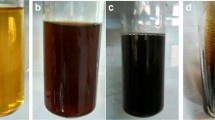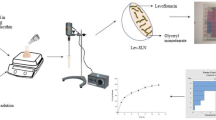Abstract
Response surface methodology utilizing the central composite rotatable design version was made use of to optimize formulation of ansamycin-loaded polymeric nanoparticles. The central composite rotatable design including three-factored factorial designs with 3 levels was utilized in this research study. The drug encapsulation efficiency, particle size and zeta potential of the nanoparticles were examined relative to 3 independent variables consisting of polymer concentration (X1), surfactant concentration (X2) and also proportion of organic to aqueous phase volume (X3). The outcome revealed that the ideal formula can be gotten from this response surface methodology. The ideal solution for the nanoparticles was made up of polymer concentration (X1) of 5% w/v, surfactant concentration (X2) of 1% w/v and also proportion of aqueous to organic phase volume (X3) of 10:1 v/v. Ansamycin nanoparticles under the optimized conditions generated the encapsulation efficiency of 89%, mean particle size of 121 nm and zeta potential value of − 25 mV. SEM of the optimized polymeric nanoparticle showed spherical particles. The in vitro experiments verified that ansamycin in the polymeric nanoparticles released progressively over the duration of 36 h. This research study revealed that the response surface methodology central composite rotatable design can successfully be gotten the modelling of ansamycin polymeric nanoparticles.














Similar content being viewed by others
References
Keerthi Nair, G. S., Ramaiyan, V., & Sathesh Kumar, S. (2018). Enhancement of drug permeability across blood brain barrier using nanoparticles in meningitis. Inflamopharmacology, 26, 675–684.
Ak, G., Viswanadhan, V. N., & Wendoloski, J. J. (1999). Acknowledge based approach in designing combinatorial or medicinal chemistry libraries for drug discovery. A qualitative and quantitative. Journal of Combinatorial Chemistry, 1, 55–68.
Lipinski, C. A. (2000). Drug-like properties and the causes of poor solubility and poor permeability. Journal of Pharmacological and Toxicological Methods, 44, 235–249.
Paul, D. R., & Robeson, L. M. (2008). Polymer nanotechnology: nanocomposites. Polymer, 49, 3187–3204.
Njuguna, J., & Pielichowski, K. (2003). Polymer nanocomposites for aerospace applications: properties. Advanced Engineering Materials, 5, 769–778.
Hule, R. A., & Pochan, D. J. (2007). Polymer nanocomposites for biomedical applications. MRS Bulletin, 32, 354–358.
Crosby, A. J., & Lee, J. Y. (2007). Polymer nanocomposites: the nano effect on mechanical properties. Polymer Reviews, 47, 217–229.
De Volder, M. F. L., Tawfick, S. H., Baughman, R. H., & Hart, A. J. (2013). Carbon nanotubes: present and future commercial applications. Science, 339, 535–539.
Rhim, J. W., Park, H. M., & Ha, C. S. (2013). Bio-nanocomposites for food packaging applications. Progress in Polymer Science, 38, 1629–1652.
Mittal, V. (2013). Polymer nanocomposite coatings. CRC Press.
Moore, J., & Flanner, H. (1991). Mathematical comparison of dissolution profiles. Pharmaceutical Technology, 2064–2074.
Qi, X., Tan, C., Wei, J., & Zhang, H. (2013). Synthesis of graphene-conjugated polymer nanocomposites for electronic device applications. Nanoscale, 5, 1440–1451.
Huang, X., & Jiang, P. (2005). Core-shell structured high-k polymer nanocomposites for energy storage and dielectric applications. Advanced Materials, 27, 546–554.
Crowley, C., Birchall, M., & Seifalian, A. M. (2005). Trachea transplantation: from laboratory to patient. Journal of Tissue Engineering and Regenerative Medicine, 9, 357–367.
Huang, Y. B., Tsai, Y. H., & Yang, W. C. (2004). Once-daily propranolol extended-release tablet dosage form: formulation design and in vitro/in vivo investigation. European Journal of Pharmaceutics and Biopharmaceutics, 58, 607–614.
Ribeiro, S., Hussain, N., & Florence, A. T. (2005). Release of DNA from dendriplexes encapsulated in PLGA nanoparticles. International Journal of Pharmaceutics, 298, 354–360.
Ahn, J. H., Kim, Y. P., & Lee, Y. M. (2008). Optimization of microencapsulation of seed oil by response surface methodology. Food Chemistry, 107, 98–105.
Myers, R. H., & Montgomery, D. C. (2002). Response surface methodology: process and product optimization using designed experiments. New York: Wiley.
Zweers, M. L., Grijpma, D. W., & Engbers, G. H. (2003). The preparation of monodisperse biodegradable polyester nanoparticles with a controlled size. Journal of Biomedical Materials Research. Part B, Applied Biomaterials, 66, 559–566.
Murakami, H., Kawashima, Y., & Niwa, T. (1997). Influence of the degrees of hydrolyzation and polymerization of poly(vinylalcohol) on the preparation and properties of poly(dl-lactide-co-glycolide) nanoparticle. International Journal of Pharmaceutics, 149, 43–49.
Gorner, T., Gref, R., & Michenot, D. (1999). Lidocaine-loaded biodegradable nanospheres. Optimization of the drug incorporation into the polymer matrix. Journal of Controlled Release, 57, 259–268.
Budhian, A., Siegel, S. J., & Winey, K. L. (2005). Production of haloperidol-loaded PLGA nanoparticles for extended controlled drug release of haloperidol. Journal of Microencapsulation, 22, 773–785.
Krishnamachari, Y., Madan, P., & Lin, S. (2007). Development of pH- and time-dependent oral microparticles to optimize budesonide delivery to ileum and colon. International Journal of Pharmaceutics, 338, 238–247.
Wong, H. L., Bendayan, R., & Rauth, A. M. (2007). Chemotherapy with anticancer drugs encapsulated in solid lipid nanoparticles. Advanced Drug Delivery Reviews, 59, 491–504.
Jain, V., Jain, S., & Mahajan, S. C. (2015). Nanomedicines based drug delivery systems for anti-cancer targeting and treatment. Current Drug Delivery, 12, 177–191.
Acknowledgments
Authors express their gratitude to the School of Pharmaceutical sciences, Vels Institute of Science Technology and Advanced Studies, Chennai, India.
Author information
Authors and Affiliations
Contributions
KGS formulated, optimized and characterized the nanoforumulations and also writing the manuscript. RV was again a major contributor in reviewing the manuscript. SS approved the final manuscript. All authors read and approved the final manuscript.
Corresponding author
Ethics declarations
Competing Interests
The authors declare that they have no competing interests.
Research Involving Human Participants or Animals
None.
Informed Consent
None.
Additional information
Publisher’s Note
Springer Nature remains neutral with regard to jurisdictional claims in published maps and institutional affiliations.
Rights and permissions
About this article
Cite this article
Nair, K.G.S., Velmurugan, R. & Sukumaran, S.K. Formulation and Optimization of Ansamycin-Loaded Polymeric Nanoparticles Using Response Surface Methodology for Bacterial Meningitis. BioNanoSci. 10, 279–291 (2020). https://doi.org/10.1007/s12668-019-00713-0
Published:
Issue Date:
DOI: https://doi.org/10.1007/s12668-019-00713-0




